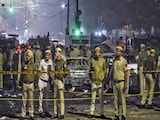- National Mission for Clean Ganga launched a project led by IIT Kanpur using Corona satellite images
- The project compares 1965 and 2018-19 images to study changes in Ganga’s morphology
- A Web-GIS library and interactive platform will aid future policy and river management decisions
The Uttar Pradesh government announced on Monday that, in a historic initiative to chart a course for the Ganga River's future through its past, the National Mission for Clean Ganga (NMCG) had launched a major project led by IIT Kanpur.
Researchers at the institute have combined rare images captured in 1965 by the American spy satellite series 'Corona' with advanced satellite imagery from 2018-19 to record major changes in the river's morphology, flow, and land use over the last five decades.
"This study is being hailed as a milestone in developing a data-driven and concrete blueprint for Ganga's conservation and restoration. The project would form part of the Ganga Knowledge Centre, which is a repository of research, portals, and datasets related to Ganga and would facilitate scientific and research-based decision-making for the river's rejuvenation," the government said in a statement.
"The Corona images capture the Ganga in an almost untouched form, while the 2019 images reveal the changing reality, where barrages, embankments, and urban sprawl have restricted the river's meandering pace. This comparative study now offers fresh hope. Scientists now have concrete maps that indicate areas where restoration could help the Ganga regain its old rhythm and where improved land use could enhance its health," it added.
According to the government, this major NMCG project is not only creating a scientific record of changes in the river's geomorphology but is also highlighting, through a comparative study of Land Use and Land Cover (LULC), how encroachment, rapid urban expansion, and agricultural growth are impacting the river's natural balance.
Based on these findings, an advanced Web-GIS library is being developed, which will be directly used in future policies, river management strategies, and restoration plans.
"As a step forward, the NMCG would be hosting the Corona and LULC data on an interactive user interface and the Google Earth Engine application, allowing both analysis and planning to be done on the same platform," the government mentioned.
The project will also prepare special digital displays for nine major windows -- Haridwar, Bijnor, Narora, Kanpur, Allahabad, Varanasi, Patna, Bhagalpur, and Farakka -- which will play a vital role in decision-making from local to national levels.
The government noted that in order to create a scientific health map of the Ganga, several decisive steps are being undertaken in the new project.
It explained that first, the entire Ganga basin's boundaries will be delineated and accurately mapped using the Corona imagery.
Comparing images from 1965-75 to the present-day landscape will provide a clear visualisation of land use and geomorphic changes.
All data will be organised into a Web-GIS module with an advanced query system, enabling researchers and planners to access the specific data they need instantly.
A system for public dissemination of data would facilitate its use in future research on the Ganga across the diverse stakeholders.
IIT Kanpur scientists believe this achievement marks the beginning of a new era of "data-driven" planning in Ganga conservation, according to the statement.
Technical challenges remain, but the research team is continually refining its methodology with each step toward greater accuracy and faster processing, bringing the picture of the Ganga's future into sharper focus.
"There could be no better guide for the Ganga's rejuvenation than precise images of its past'?and this is exactly the path this project is showing," the government said.
"By blending the solid foundation of science with the deep roots of tradition, this effort by the National Mission for Clean Ganga is emerging as a historic step toward returning the Ganga to its clean, free, and life-giving form for generations to come," it added.
(Except for the headline, this story has not been edited by NDTV staff and is published from a syndicated feed.)















